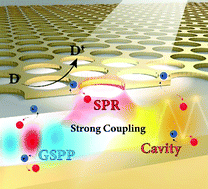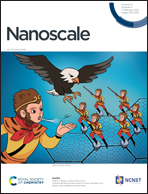Enhancing plasmonic hot-carrier generation by strong coupling of multiple resonant modes†
Abstract
Plasmon-induced hot carriers have recently attracted considerable interest, but the energy efficiency in visible light is often low due to the short lifetime of hot carriers and the limited optical absorption of plasmonic architectures. To increase the generation of hot carriers, we propose to exert multiple plasmonic resonant modes and their strong coupling using a metal–dielectric–metal (MDM) nanocavity that comprises an Au nanohole array (AuNHA), a TiO2 thin film and an Au reflector. Unlike common MDM structures, in addition to the Fabry-Pérot mode in the dielectric layer, AuNHA as the top layer is special because it excites the localized surface plasmon resonance (LSPR) mode in the Au nanoholes and launches the gap surface plasmon polariton (GSPP) mode in the Au reflector surface. The spatial field overlapping of the three resonance modes enables strong mode coupling by optimizing the TiO2 thickness, which leads to notably enhanced average IPCE (∼1.5%) and broadband photocurrent (170 μA·cm−2). This MDM structure would be useful for photochemistry and photovoltaics using sunlight.

- This article is part of the themed collection: Advances in Plasmonics and Its Applications


 Please wait while we load your content...
Please wait while we load your content...